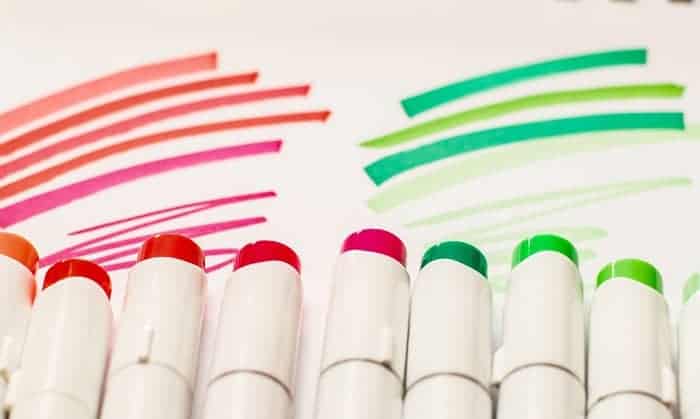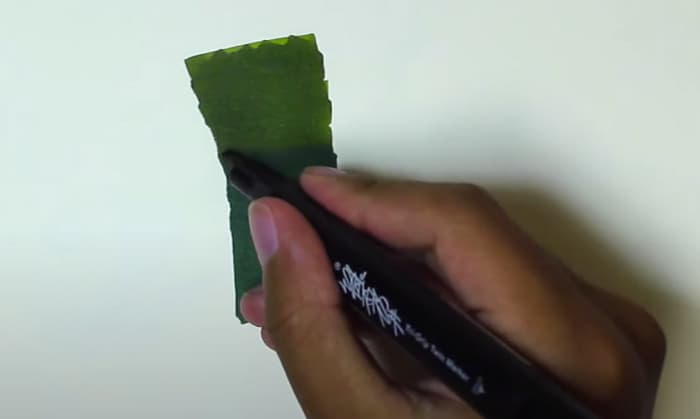Is this your first time using alcohol-based markers? Working with new mediums can feel intimidating but worry not! I’m here to share some tips and tricks on how to use alcohol markers properly.
Many illustrators, designers, and crafters choose alcohol-based markers as the main medium. Known for their versatility, they are useful for sketching, coloring, and hand-lettering. But what sets them apart is their ability to produce ultra-smooth gradients, which is why they are also called “blending markers.”
Before we begin with the tutorials, let me discuss the supplies that you need. Unless you’re well-acquainted with alcohol-based markers, don’t skip this part as this information will prevent you from running into certain issues.
Table of Contents
What You Need
Alcohol-based markers
Most brands sell markers in sets and individually. Some sets are packaged specifically for portraiture, manga, or landscape. If you’re unsure, you can start with a set of 12 basic colors.
You also need to determine the nibs that you need for your art projects. In general, alcohol-based markers have dual-tips, which could either be a combination of brush nibs, wedge nibs, and bullet or fine nibs. The brush nib is excellent for coloring and blending. Meanwhile, the bullet nibs are useful for detail work while the wedge nib fills in large areas with colors.
Paper
Although most blending markers can work on a variety of surfaces, let’s focus on paper. Certain blending techniques work only on paper and it’s best to learn the basics first.
I highly recommend using marker papers or pads, cardstock, and bristol paper. These types of papers are less likely to cause feathering, thereby keeping the edges of your drawing sharp. Hot-pressed watercolor papers and mixed-media pads are also great alternatives for as long as the texture is mild.
Some artists prefer rough textures as they can produce unique effects but this may also fray the nibs of your markers faster.
Other supplies
Using a pencil to sketch outlines is a good practice as it helps you plan and determine where each color should be applied. If you make a mistake, you can simply rub it out with an eraser.
Besides pencil and eraser, I also suggest pairing your alcohol-based markers with felt-tipped pens, fineliners, or gel pens. Black fineliners pens are great for outlining but you can use other colored pens for details.
Alcohol-based inks are prone to bleeding even on thick marker papers, especially when you apply several layers of ink. Be sure to place a thick scrap paper underneath the paper you are working on to prevent the ink from bleeding on your desk or a fresh page of a marker pad.
How to Use Alcohol Based Markers Instructions
Basic shading
Choose any alcohol-based marker from your set and use the brush or wedge nib to shade in a side-to-side motion just like you would with pencils.
As an experiment, try to form 2 squares as you shade. In the first square, shade slowly and in the second one, do it quicker. You will notice that when you shade slowly, the square becomes streaky. In contrast, the streaks are faint when you shade faster. That’s because the paper is still wet when you add multiple layers of ink on the same square, as explained in this article by The Virtual Instructor.
Tip: Since alcohol-based inks dry fast, you need to shade quickly enough to produce smooth blends of colors. If you do not intend to blend two hues, you can simply allow the base layer to dry.
Layering
With your chosen color, create a base layer using the technique I demonstrated in basic shading and form a long rectangle. Try not to go over the same area twice to keep the color light.
Apply another layer of the same color on the ¾ of the rectangle. Repeat this process on half of the shape then finish off by adding another layer on the ¼. You will notice that the color darkens as you add layers of the same ink. This technique is suitable for creating highlights and shadows.
Tip: It is best to start with a lighter shade than the other way around. According to this Art is Fun article; however, you can use Copic’s colorless blender to add highlights by lifting the ink off the paper. Furthermore, it lets you fix coloring errors.
Blending
In this blending tutorial, I will be discussing a technique that applies to alcohol-based markers in general. Note that brands like Chameleon include a mixing chamber in their set. Please read the manufacturer’s instructions.
Choose 2 to 3 different colors or hues of the same color family. Using this blending technique, you can blend analogous colors or complementary colors. As an example, let’s use yellow and orange.
Start by sketching a square and color with your yellow marker as demonstrated in the guide I shared on Basic Shading.
Grab your orange marker and apply it on top of the yellow square before it dries completely. Continue shading beyond the yellow square. Even without a colorless blender, you can see that the overlapping orange and yellow can produce a “yellow-orange” hue.
Optional: You can smoothen out the color transition using a colorless blender.
Tip: Refer to the color wheel to get a better idea of the colors that you can combine. Technically, it is much easier to create smoother blends with color tones that are closer to each other as explained in this Art Tutor article. However, you can create unique colors by mixing 2 colors using this technique.
Creating textures
Pick any color from your alcohol-based marker set. Any nib can create a texture but for this tutorial, I recommend trying the techniques below using both nibs of your dual-tipped markers.
Lines: Create about 1 inch horizontal, diagonally, or vertical lines with quick strokes. You can start by touching the tip of the marker on the paper and lift it towards the end, just like you would when making checkmarks. You can do this several times until you form a texture. This technique can be used to create grass or wood textures.
Dots: Touch the tip of the nib on the paper and lift it right away. Repeat this process and make sure to place each dot very close to the other. Notice that each type of nib produces unique dots. You can use this technique to draw leaves on trees.
Cleaning your nibs
Whether you’re using a colorless blender or a regular alcohol-based marker, make it a point to clean your nibs after blending. This way, you won’t transfer any ink on the other parts of the illustration as this can be hard to remove once on paper.
To remove the ink off the nib from another marker, rub it on a scrap paper continuously until the stray color is gone as demonstrated in this Copic Thinking article. You can also use the chipboard at the back of the sketchpad to scrub out the ink.
Tip: If you outlined your illustration with a black felt tip pen or fineliner, be sure to allow the ink to dry completely before coloring with alcohol-based markers. This will prevent the black ink from getting on your marker’s nib.
Conclusion
Did you learn some cool tricks from this tutorial on using alcohol-based markers? These techniques may sound basic but I have to admit that it is easier said than done. It takes some practice before you can master these techniques and apply them to more complex illustrations.
On that note, don’t hesitate to reach out through the comments section and talk about your experience in using your blending markers. Aside from that, it would be a huge help to other aspiring artists to learn these techniques. If you know anyone who needs this tutorial, please share it!

Art has always been a part of my life; it influences my upbringing and later my career choice. For me, it is always a part of my parenting technique. So for whichever purpose that you come to art, you can start here with us.




